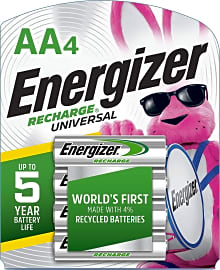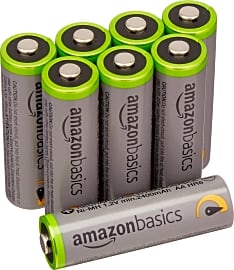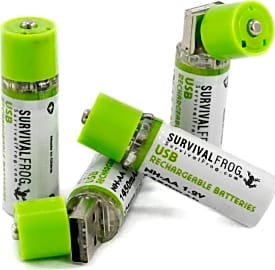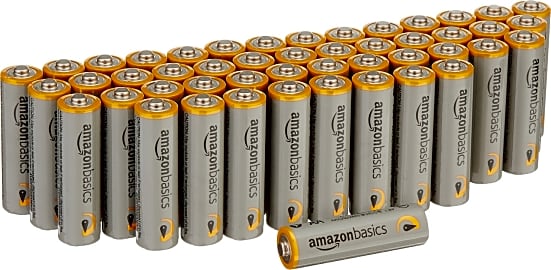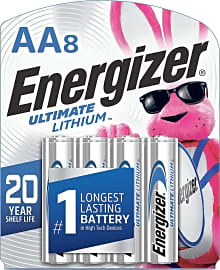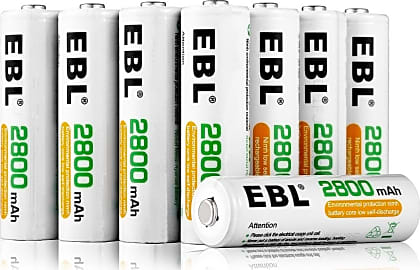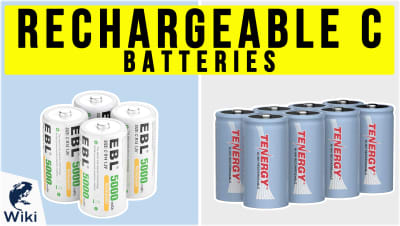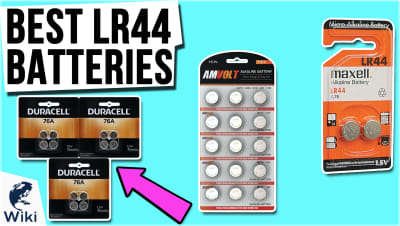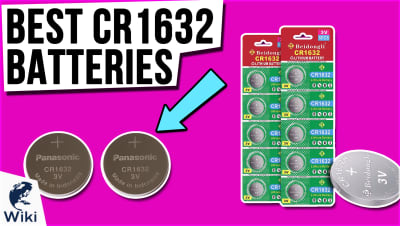The 10 Best AA Batteries

This wiki has been updated 35 times since it was first published in June of 2016. Is anything more frustrating than being in the middle of watching a thrilling movie or sporting event on TV and reaching for the remote control to pause the action only to find the clicker is out of juice? We've researched a variety of quality AA batteries so you can make certain you're never left without power again for all your flashlights, cameras, and other devices. When users buy our independently chosen editorial selections, we may earn commissions to help fund the Wiki.
Editor's Notes
October 06, 2020:
Thanks to their reliability, value for the cost, and long-lasting power, the Panasonic Eneloop still come out on top, and we've added the Panasonic Eneloop Pro, as well. The Pro version has a 2,550-mAh capacity to the Eneloop's 2,000-mAh capacity; however, the Pro version offers 500 charge cycles, whereas the Eneloop can be recharged up to 2,100 times. You should choose the Pro version, then, when high-powered performance is crucial, even if you expect to have to replace them sooner. Both are available for purchase with or without a charger, and both also come in AAA versions.
Outside of Panasonic, there remain plenty of other great rechargeable choices, including the perennially popular Energizer Recharge Universal and the wallet-friendly AmazonBasics High-Capacity Rechargeables. But we've replaced the Hitrends Rechargeables with the Survival Frog EasyPower, a USB choice that's similar to the former. The Survival Frog batteries seem to have a slight edge over the Hitrends model when it comes to durability.
Finally, if it's simple alkaline batteries you seek, look to the Rayovac High Energy or the AmazonBasics Performance Alkaline, if the budget is tight, or the Duracell Quantum Alkaline, which are better quality but more expensive. The former two are offered in high-quantity packages; consider a top-notch battery case to go with them, which will make storing such large quantities much easier.
May 27, 2019:
AA batteries have become the workhorses of our digital age, powering everything from mice to keyboards to cameras to game controllers, and it is now necessary to have a supply of them on hand. Alkaline units cost less in the short run, but rechargeable cells have closed the capacity and shelf-life gap with their alkaline cousins, so our selections include samples of both. We were especially pleased to find the cleverly designed Hitrends Rechargeables, which you can quickly juice up from any USB port.
Special Honors
The Battery Eliminator Store AA Eliminator As long as the device you want to power is and will remain next to a power outlet, The Battery Eliminator Store AA Eliminator is a choice that can save you some money in the long run. It fits into a battery compartment pretty much the same way that a battery would, but you may need to create a small notch in the compartment door to accommodate the cord. batteryeliminatorstore.com
Fanfare For The Common Battery: The AA
Their price does make them an illogical choice for many purposes, though.
The AA battery was first introduced well over a hundred years ago. It was only the latest iteration of dry cell battery technology, which had been refined over the course of the 19th Century. But this slender cylinder would prove to be one of the most popular battery sizes ever created. By the middle of the 20th Century, the AA size we use today had been fully standardized. From then on, it was only a matter of refining the internal workings of these compact, common sources of energy, and today the modern consumer has three major categories of AA battery from which to choose.
The first is well-known to all: the single-use disposable alkaline AA battery. Trusted for decades, these batteries are affordable and effective, readily powering devices ranging from flashlights to cameras to music players and beyond. Alkaline AA batteries produce a 1.5 volt output that, under most circumstances, will remain steady until the battery's stored energy is depleted. Despite their many obvious benefits, including the aforementioned low cost and their reliable long shelf life, such batteries do have drawbacks. Many alkaline batteries are only suited for low drain devices like a clock or remote control, for example. Alkaline batteries are also notorious for leaking "battery acid," which is ironic, for indeed the fluid they may leak is aqueous potassium hydroxide, a basic solution. These leaks are not particularly dangerous, though they can be dirty to clean and can damage electronics and hardware.
Ever more common these days are Lithium AA batteries. While notably more expensive than alkaline AAs, these batteries offer much more potential energy than their alkaline counterparts, even running certain electronics for nearly ten times longer than alkaline units. Lithium AA batteries are also lighter in weight and have an impressive shelf-stable life measured not in years, but in decades. Their price does make them an illogical choice for many purposes, though.
Finally we have the category of rechargeable AA batteries. These devices mean an initial investment that might seem greatly inflated, especially as they necessitate the purchase of a charging unit as well. However, their reusable nature will soon see rechargeable AAs pay for themselves in terms of savings.
For the person who rarely uses batteries but must have them in good working order when needed, pricey Lithium batteries can be seen as an investment in reliability. For those who need batteries for frequent but less-than-demanding low drain applications, alkaline batteries make sense. And for the person who seems himself or herself cycling through batteries all the time, spending the cash on rechargeable batteries is a wise move that will pay off over time.
The Basics: How A Battery Works
Scientists have long understood how and why a battery creates usable electricity; despite the fact that most of us use batteries every day, most members of the public are nonetheless hard-pressed to explain their function.
In fact, these and similar batteries actually create electricity by converting stored chemical energy into an electrical current.
Contrary to popular belief, a AA battery does not store electricity. In fact, these and similar batteries actually create electricity by converting stored chemical energy into an electrical current.
The AA battery has but three primary components. These include the two terminals commonly known as positive and negative but properly termed the anode and cathode. The third component is housed between these two terminals and is the electrolyte, also known as the chemical medium.
When a battery filled with potential chemical energy is inserted into a system that creates a circuit -- when both of its terminals are connected -- the chemical reaction thus triggered creates a buildup of electrons at the anode. These are then drawn away from the battery and flow through the device, powering the lightbulb, speakers, screen, or other function of the electronic unit.
Safe Battery Storage And Disposal
To exact the longest stable storage life from your batteries, they should be stored at the lower end of the room temperature scale (around sixty degrees Fahrenheit is ideal) and in a relatively dry space not subject to direct sunlight. There is no reason to store batteries in the refrigerator, and they should not be kept in a freezer; doing so can in fact damage the batteries significantly as condensation creates corrosion issues. And no matter where or how you store your batteries, you should do so in their original, factory-sealed packaging for as long as possible.
Alkaline batteries should, as much as possible, be used up completely and then discarded; there is seldom a reason to keep an alkaline battery that has been partially used.
Rechargeable batteries should be stored at about half of their power capacity; this prevents them from draining fully, which can at times render recharging impossible. Alkaline batteries should, as much as possible, be used up completely and then discarded; there is seldom a reason to keep an alkaline battery that has been partially used.
Most alkaline batteries can be safely disposed of along with the rest of your common household trash. Modern alkaline batteries found for sale in western markets feature none of the harmful chemicals, such as mercury, that once made disposal of such items a hazard. Just make sure not to dispose of a large number of alkaline batteries together, as multiple units contacting one another can create a heat or fire hazard due to traces of left over energy.
Lithium and rechargeable batteries (as well as other specialty batteries, such as those that use zinc) may require special disposal at a recycling facility. Check your region's regulations and, if this special step is requested, heed it; tossing these batteries out with the rest of the trash can allow harmful chemicals to leak into the ground, into water sources, or into the air.
And do keep in mind that just because many types of batteries can be discarded in the trash, they can still be recycled, and taking the step to do so is a great way to minimize the negative impact your activity has on the planet.


